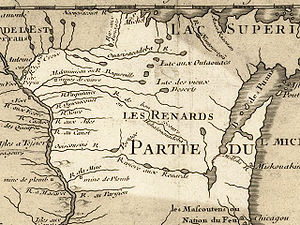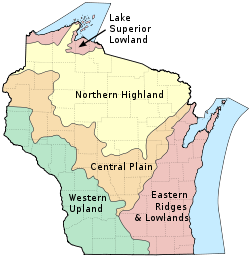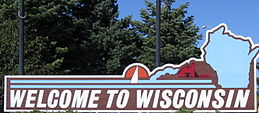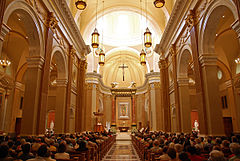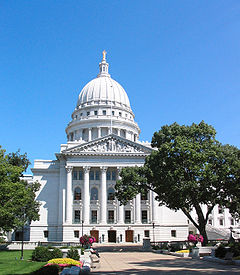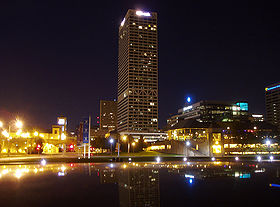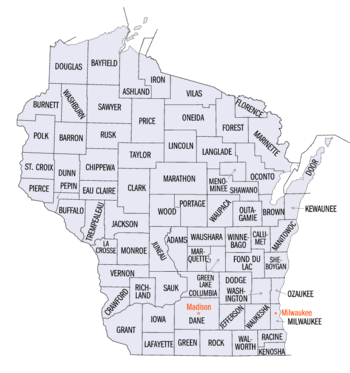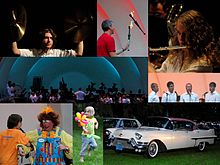- Wisconsin
-
This article is about the U.S. state of Wisconsin. For the river, see Wisconsin River. For other uses, see Wisconsin (disambiguation).
State of Wisconsin 

Flag Seal Nickname(s): Badger State; America's Dairyland Motto(s): Forward Official language(s) De jure: None
De facto: EnglishDemonym Wisconsinite Capital Madison Largest city Milwaukee Largest metro area Milwaukee metropolitan area Area Ranked 23rd in the U.S. - Total 65,497.82 sq mi
(169,639 km2)- Width 260 miles (420 km) - Length 310 miles (500 km) - % water 17 - Latitude 42° 37′ N to 47° 05′ N - Longitude 86° 46′ W to 92° 53′ W Population Ranked 20th in the U.S. - Total (2010) 5,686,986 - Density 103.4/sq mi (39.9/km2)
Ranked 25th in the U.S.- Median income $47,220 (15th) Elevation - Highest point Timms Hill[1][2]
1,951 ft (595 m)- Mean 1,050 ft (320 m) - Lowest point Lake Michigan[1][2]
579 ft (176 m)Before statehood Wisconsin Territory Admission to Union May 29, 1848 (30th) Governor Scott Walker (R) Lieutenant Governor Rebecca Kleefisch (R) Legislature Wisconsin Legislature - Upper house Senate - Lower house State Assembly U.S. Senators Herb Kohl (D)
Ron Johnson (R)U.S. House delegation 5 Republicans, 3 Democrats (list) Time zone Central: UTC-6/-5 Abbreviations WI Wis. US-WI Website wisconsin.gov Wisconsin
 i/wɪsˈkɒnsɨn/ is a U.S. state located in the north-central United States and is part of the Midwest. It is bordered by Minnesota to the west, Iowa to the southwest, Illinois to the south, Lake Michigan to the east, Michigan to the northeast, and Lake Superior to the north. Wisconsin's capital is Madison, and its largest city is Milwaukee. As of 2010, the state's 72 counties have a total of 5,686,986 residents.[3]
i/wɪsˈkɒnsɨn/ is a U.S. state located in the north-central United States and is part of the Midwest. It is bordered by Minnesota to the west, Iowa to the southwest, Illinois to the south, Lake Michigan to the east, Michigan to the northeast, and Lake Superior to the north. Wisconsin's capital is Madison, and its largest city is Milwaukee. As of 2010, the state's 72 counties have a total of 5,686,986 residents.[3]Contents
Etymology
The word Wisconsin originates from the name given to the Wisconsin River by one of the Algonquian speaking American Indian groups living in the region at the time of European contact.[4] French explorer Jacques Marquette was the first European to reach the Wisconsin River and record its name, arriving in 1673 and calling the river Meskousing in his journal.[5] This spelling was later corrupted to Ouisconsin by other French explorers, and over time this version became the French name for both the Wisconsin River and the surrounding lands. English speakers anglicized the spelling to its modern form when they began to arrive in greater numbers during the early 19th Century. The current spelling was made official by the legislature of Wisconsin Territory in 1845.[6]
Throughout the course of its many variations, the Algonquian word for Wisconsin and its original meaning have both grown obscure. Interpretations may vary, but most implicate the river and the red sandstone that line its banks. One leading theory holds that the name originated from the Miami word Meskonsing, meaning "it lies red," a reference to the setting of the Wisconsin River as it flows by the reddish sandstone of the Wisconsin Dells.[7] Numerous other theories have also been widely publicized, including claims that name originated from one of a variety of Ojibwa words meaning "red stone place," "gathering of the waters," or "great rock."[8]
History
Wisconsin has been home to a wide variety of cultures over the past twelve thousand years. The first people arrived around 10000 BCE during the Wisconsin Glaciation. These early inhabitants, called Paleo-Indians, hunted now-extinct ice age animals exemplified by the Boaz mastodon, a prehistoric mastodon skeleton unearthed along with spear points in southwest Wisconsin.[9] After the ice age ended around 8000 BCE, people in the subsequent Archaic period lived by hunting, fishing, and gathering food from wild plants. Agricultural societies emerged gradually over the Woodland period between 1000 BCE to 1000 CE. Toward the end of this period, Wisconsin was the heartland of the "Effigy Mound culture," which built thousands of animal-shaped mounds across the landscape.[10] Later, between 1000 and 1500 CE, the Mississippian and Oneota cultures built substantial settlements including the fortified village at Aztalan in southeast Wisconsin.[11] The Oneota may be the ancestors of the modern Ioway and Ho-Chunk tribes, who shared the Wisconsin region with the Menominee at the time of European contact.[12] Other American Indian groups living in Wisconsin when Europeans first settled included the Ojibwa, Sauk, Fox, Kickapoo, and Pottawatomie, who migrated to Wisconsin from the east between 1500 and 1700.[13]
 Jean Nicolet, depicted in a 1910 painting by Frank Rohrbeck, was probably the first European to explore Wisconsin. The mural is located in the Brown County Courthouse in Green Bay.
Jean Nicolet, depicted in a 1910 painting by Frank Rohrbeck, was probably the first European to explore Wisconsin. The mural is located in the Brown County Courthouse in Green Bay.
The first European to visit what became Wisconsin was probably the French explorer Jean Nicolet. He canoed west from Georgian Bay through the Great Lakes in 1634, and it is traditionally assumed that he came ashore near Green Bay at Red Banks.[14] Pierre Radisson and Médard des Groseilliers visited Green Bay again in 1654 – 1666 and Chequamegon Bay in 1659 – 1660, where they traded for fur with local American Indians.[15] In 1673, Jacques Marquette and Louis Jolliet became the first to record a journey on the Fox-Wisconsin Waterway all the way to the Mississippi River near Prairie du Chien.[16] Frenchmen like Nicholas Perrot continued to ply the fur trade across Wisconsin through the 17th and 18th centuries, but the French made no permanent settlements in Wisconsin before Great Britain won control of the region following the French and Indian War in 1763. Even so, French traders continued to work in the region after the war, and some, beginning with Charles de Langlade in 1764, now settled in Wisconsin permanently rather than returning to British-controlled Canada.[17]
Wisconsin became a territorial possession of the United States in 1783 after the American Revolutionary War. However, the British remained in de facto control until after the War of 1812, which finally established an American presence in the area.[18] Under American control, the economy of the territory shifted from fur trading to lead mining. The prospect of easy mineral wealth drew immigrants from throughout the U.S. and Europe to the lead deposits located at Mineral Point, Wisconsin and nearby areas. Some miners found shelter in the holes they had dug and earned the nickname "badgers," leading to Wisconsin's identity as the "Badger State."[19] The sudden influx of white miners prompted tension with the local Native American population. The Winnebago War of 1827 and the Black Hawk War of 1832 led to the forced removal of American Indians from most parts of the state.[20] Following these conflicts, Wisconsin Territory was organized in 1836. Continued white settlement led to statehood in 1848.
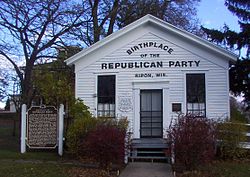 The Little White Schoolhouse in Ripon, Wisconsin held the nation's first meeting of the Republican Party
The Little White Schoolhouse in Ripon, Wisconsin held the nation's first meeting of the Republican Party
Politics in early Wisconsin were defined by the greater national debate over slavery. A free state from its foundation, Wisconsin became a center of northern abolitionism. The debate became especially intense in 1854 after a runaway slave from Missouri named Joshua Glover was captured in Racine. Glover was taken into custody under the Federal Fugitive Slave Law, but a mob of abolitionists stormed the prison where Glover was held and helped him escape to Canada. The Wisconsin Supreme Court ultimately declared the Fugitive Slave Law unconstitutional in a trial stemming from the incident.[21] The Republican Party, founded on March 20, 1854, by anti-slavery expansion activists in Ripon, Wisconsin, grew to dominate state politics in the aftermath of these events.[22] During the Civil War, around 91,000 troops from Wisconsin fought for the Union.[23]
Wisconsin's economy also diversified during the early years of statehood. While lead mining diminished, agriculture became a principal occupation in the southern half of the state. Railroads were built across the state to help transport grains to market, and industries like J.I. Case & Company in Racine were founded to build agricultural equipment. Wisconsin briefly became one of the nation's leading producers of wheat during the 1860s.[24] Meanwhile, the lumber industry dominated in the heavily forested northern sections of Wisconsin, and sawmills sprang up in cities like La Crosse, Eau Claire, and Wausau. These economic activities had dire environmental consequences. By the close of the 19th century, intensive agriculture had devastated soil fertility, and lumbering had deforested most of the state.[25] This forced both wheat agriculture and the lumber industry into a precipitous decline.
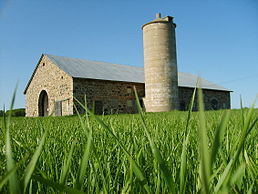 The Daniel E. Krause Stone Barn in Chase, Wisconsin was built in 1903 as dairy farming spread across the state
The Daniel E. Krause Stone Barn in Chase, Wisconsin was built in 1903 as dairy farming spread across the state
Beginning in the 1890s, farmers in Wisconsin shifted from wheat to dairy production in order to make more sustainable and profitable use of their land. Many immigrants carried cheese-making traditions that, combined with the state's suitable geography and dairy research led by Stephen Babcock at the University of Wisconsin, helped the state build a reputation as "America's Dairyland."[26] Meanwhile, conservationists including Aldo Leopold helped reestablish the state's forests during the early 20th century, [27] paving the way for a more renewable lumber and paper milling industry as well as promoting recreational tourism in the northern woodlands. Manufacturing also boomed in Wisconsin during the early 20th century, driven by an immense immigrant workforce arriving from Europe. Industries in cities like Milwaukee ranged from brewing and food processing to heavy machine production and toolmaking, leading Wisconsin to rank 8th among U.S. states in total product value by 1910.[28]
The early 20th century was also notable for the emergence of progressive politics championed by Robert M. La Follette. Between 1901 and 1914, Progressive Republicans in Wisconsin created the nation's first comprehensive statewide primary election system,[29] the first effective workplace injury compensation law,[30] and the first state income tax,[31] making taxation proportional to actual earnings. The progressive Wisconsin Idea also promoted the statewide expansion of the University of Wisconsin through the UW-Extension system at this time.[32] Later, UW economics professors John R. Commons and Harold Groves helped Wisconsin create the first unemployment compensation program in the United States in 1932.[33]
Wisconsin took part in several political extremes in the mid to late 20th century, ranging from the anti-communist crusades of Senator Joseph McCarthy in the 1950s to the radical antiwar protests at UW-Madison that culminated in the Sterling Hall bombing in August 1970. Recent politics have been comparatively moderate, but the state has continued to push forward new ideas, most notably becoming a leader in welfare reform under Republican Governor Tommy Thompson during the 1990s.[34] The state's economy also underwent further transformations towards the close of the century, as heavy industry and manufacturing declined in favor of a service economy based on medicine, education, agribusiness, and tourism.
Two U.S. Navy battleships, BB-9 and BB-64, were named USS Wisconsin in honor of this state.
State Symbols
- State Motto: Forward
- State Song: On Wisconsin!
- State Flower: Wood Violet
- State Bird: Robin
- State Tree: Sugar Maple
- State Fish: Muskellunge
- State Animal: Badger
- State Wildlife Animal: White-Tailed Deer
- State Domesticated Animal: Dairy Cow
- State Mineral: Galena
- State Rock: Red Granite
- State Symbol of Peace: Mourning Dove
- State Insect: Honey Bee
- State Soil: Antigo Silt Loam
- State Fossil: Trilobite
- State Dog: American Water Spaniel
- State Beverage: Milk
- State Grain: Corn
- State Dance: Polka
- State Dessert: Cream Puff
Geography
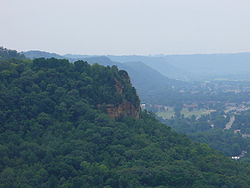 The Driftless Area of southwestern Wisconsin is characterized by bluffs carved in sedimentary rock by water from melting Ice Age glaciers.
The Driftless Area of southwestern Wisconsin is characterized by bluffs carved in sedimentary rock by water from melting Ice Age glaciers.
Wisconsin is bordered by the Montreal River; Lake Superior and Michigan to the north; by Lake Michigan to the east; by Illinois to the south; and by Iowa to the southwest and Minnesota to the northwest. A border dispute with Michigan was settled by two cases, both Wisconsin v. Michigan, in 1934 and 1935. The state's boundaries include the Mississippi River and St. Croix River in the west, and the Menominee River in the northeast. Wisconsin is the northernmost state that does not share a border with Canada.[citation needed]
With its location between the Great Lakes and the Mississippi River, Wisconsin is home to a wide variety of geographical features. The state is divided into five distinct regions. In the north, the Lake Superior Lowland occupies a belt of land along Lake Superior. Just to the south, the Northern Highland has massive mixed hardwood and coniferous forests including the 1,500,000 acres (6,100 km2) Chequamegon-Nicolet National Forest, as well as thousands of glacial lakes, and the state's highest point, Timms Hill. In the middle of the state, the Central Plain has some unique sandstone formations like the Dells of the Wisconsin River in addition to rich farmland. The Eastern Ridges and Lowlands region in the southeast is home to many of Wisconsin's largest cities. The ridges include the Niagara Escarpment that stretches from New York State, the Black River Escarpment and the Magnesian Escarpment.[35][36] The bedrock of the Niagara Escarpment is dolomite, while the two shorter ridges have limestone bedrock. In the southwest, the Western Upland is a rugged landscape with a mix of forest and farmland, including many bluffs on the Mississippi River. This region is part of the Driftless Area, which also includes portions of Iowa, Illinois, and Minnesota. This area was not covered by glaciers during the most recent ice age, the Wisconsin Glaciation.
Overall, 46% of Wisconsin's land area is covered by forest. Langlade County has a soil rarely found outside of the county called Antigo Silt Loam.
Areas under the management of the National Park Service include the following:[37]
- Apostle Islands National Lakeshore along Lake Superior
- Ice Age National Scenic Trail
- North Country National Scenic Trail
- Saint Croix National Scenic Riverway
There is one national forest managed by the U.S. Forest Service in Wisconsin, Chequamegon-Nicolet National Forest.
Wisconsin has sister-state relationships with the Germany's Hesse, Japan's Chiba Prefecture, Mexico's Jalisco, China's Heilongjiang, and Nicaragua.[38]
Wisconsin has seven locations in which you can stand in four counties at one time (4 corners), even with the counties' borders often being river-based.
Climate
Wisconsin's climate is classified as humid continental. The highest temperature ever recorded in the state was in the Wisconsin Dells, on July 13, 1936, where it reached 114 °F (46 °C). The lowest temperature ever recorded in Wisconsin was in the village of Couderay, where it reached −55 °F (−48 °C) on both February 2 and February 4, 1996.[39]
Monthly Normal High and Low Temperatures For Selected Wisconsin Cities [°F (°C)] City Jan Feb Mar Apr May Jun Jul Aug Sep Oct Nov Dec Green Bay 24/7 (−4/-14)
29/12 (−2/-11)
40/23 (4/-5)
55/34 (13/1)
68/45 (20/7)
77/54 (25/12)
81/59 (27/15)
78/56 (26/13)
70/48 (21/9)
58/37 (14/3)
42/26 (6/-3)
29/13 (−2/-11)
La Crosse 26/6 (−3/-14)
32/13 (0/-11)
45/24 (7/-4)
60/37 (16/3)
72/49 (22/9)
81/58 (27/14)
85/63 (29/17)
82/61 (28/16)
74/52 (23/11)
61/40 (16/4)
44/27 (7/-3)
30/14 (−1/-10)
Madison 25/9 (−4/-13)
31/14 (−1/-10)
43/25 (6/-4)
57/35 (14/2)
69/46 (21/8)
78/56 (26/13)
82/61 (28/16)
79/59 (26/15)
71/50 (22/10)
60/39 (16/4)
43/28 (6/-2)
30/16 (−1/-9)
Milwaukee 28/13 (−2/-11)
32/18 (0/-8)
43/27 (6/-3)
54/36 (12/2)
66/46 (19/8)
76/56 (24/13)
81/63 (27/17)
79/62 (26/17)
72/54 (22/12)
60/43 (16/6)
46/31 (8/-1)
33/19 (1/-7)
[3] Demographics
Historical populations Census Pop. %± 1820 1,444 — 1830 3,635 151.7% 1840 30,945 751.3% 1850 305,391 886.9% 1860 775,881 154.1% 1870 1,054,670 35.9% 1880 1,315,457 24.7% 1890 1,693,330 28.7% 1900 2,069,042 22.2% 1910 2,333,860 12.8% 1920 2,632,067 12.8% 1930 2,939,006 11.7% 1940 3,137,587 6.8% 1950 3,434,575 9.5% 1960 3,951,777 15.1% 1970 4,417,731 11.8% 1980 4,705,767 6.5% 1990 4,891,769 4.0% 2000 5,363,675 9.6% 2010 5,686,986 6.0% Since its founding, Wisconsin has been ethnically heterogeneous. Following the period of French fur traders, the next wave of settlers were miners, many of whom were Cornish, who settled the southwestern area of the state. The next wave was dominated by "Yankees," migrants from New England and upstate New York; in the early years of statehood, they dominated the state's heavy industry, finance, politics and education. Between 1850 and 1900, large numbers of European immigrants followed them, including Germans, Scandinavians (the largest group being Norwegian), and smaller groups of Belgians, Dutch, Swiss, Finns, Irish, Poles, and others. In the 20th century, large numbers of Mexicans and African Americans came, settling mainly in Milwaukee; and after end of the Vietnam War came a new influx of Hmongs.
According to the 2010 Census, the state's population is: 83.3% Caucasian, 6.3% African American, 5.9% Hispanic, 2.3% Asian,1.0% Native American, and 1.8% of mixed race.[40]
The six largest ancestry groups in Wisconsin are: German (42.6%), Irish (10.9%), Polish (9.3%), Norwegian (8.5%), English (6.5%), and Italian (6.1%).[40] German is the most common ancestry in every county in the state, except Menominee, Trempealeau and Vernon.[41] Wisconsin has the highest percentage of residents of Polish ancestry of any state.[40] The various ethnic groups settled in different areas of the state. Although Germans settled throughout the state, the largest concentration was in Milwaukee. Norwegians settled in lumbering and farming areas in the north and west. Small colonies of Belgians, Swiss, Finns and other groups settled in their particular areas, with Irish, Italian, and Polish immigrants settling primarily in urban areas.[42] African Americans came to Milwaukee, especially from 1940 on. Menominee County is the only county in the eastern United States with an American Indian majority.
Demographics of Wisconsin (csv) By race White Black AIAN* Asian NHPI* 2000 (total population) 91.52% 6.15% 1.30% 1.92% 0.08% 2000 (Hispanic only) 3.35% 0.17% 0.11% 0.03% 0.01% 2005 (total population) 91.00% 6.48% 1.30% 2.21% 0.09% 2005 (Hispanic only) 4.17% 0.20% 0.12% 0.04% 0.01% Growth 2000–05 (total population) 2.64% 8.89% 3.13% 18.59% 6.85% Growth 2000–05 (non-Hispanic only) 1.65% 8.53% 2.43% 18.63% 6.18% Growth 2000–05 (Hispanic only) 28.67% 21.23% 10.54% 16.75% 10.87% * AIAN is American Indian or Alaskan Native; NHPI is Native Hawaiian or Pacific Islander 86% of Wisconsin's African-American population live in four cities: Milwaukee, Racine, Beloit, Kenosha, with Milwaukee home to nearly three-fourths of the state's black Americans. In the Great Lakes region, only Detroit and Cleveland have a higher percentage of African-American residents.
33% of Wisconsin's Asian population is Hmong, with significant communities in Milwaukee, Wausau, Green Bay, Sheboygan, Appleton, Madison, La Crosse, Eau Claire, Oshkosh, and Manitowoc.[43]
Religion
Christianity is the predominant religion of Wisconsin. As of the year 2000, the RCMS[44] reported that the three largest denominational groups in Wisconsin are Catholic, Mainline Protestant, and Evangelical Protestant. The Catholic Church has the highest number of adherents in Wisconsin (at 1,695,660), followed by the Evangelical Lutheran Church in America with 463,432 members reported and the Lutheran Church--Missouri Synod, reporting 241,306 adherents. The percentage of Wisconsin residents who belong to various affiliations are shown below:[45]
- Christian – 80%
- Protestant – 50%
- Lutheran – 23%
- Methodist – 7%
- Baptist – 5%
- Presbyterian – 2%
- United Church of Christ – 2%
- Other Protestant or general Protestant – 15%
- Roman Catholic – 29%
- Other Christian – 2%
- Protestant – 50%
- Other religions – 1%
- Non-affiliated – 15%
Crime
Statewide FBI Crime statistics for 2009 include 144 murders/nonnegligent manslaughter; 1,108 forcible rapes; 4, 850 robberies; 8,431 aggravated assaults; and 147,486 property crimes.[46] Wisconsin also publishes its own statistics through the Office of Justice Assistance.[47] The OJA reported 14,603 violent crimes in 2009, with a clearance rate (% solved) of 50%.[48] The OJA reported 4,633 sexual assaults in 2009, with an overall clearance rate for sexual assaults of 57%. Of note, in Wisconsin juveniles are nearly three times more likely than adults to be victims of sexual assault, with 11- to 15-year-old children as the highest victimized age group.[49]
Law and government
The capital is Madison, Wisconsin.
State Executive Officers
- Governor: Scott Walker (R)
- Lieutenant Governor: Rebecca Kleefisch (R)
- Attorney General: J.B. Van Hollen (R)
- Secretary of State: Douglas LaFollette (D)
- Treasurer: Kurt W. Schuller (R)
- State Superintendent of Public Instruction (Non-partisan Office): Tony Evers
See also:
- Wisconsin Constitution
- Governors of Wisconsin
- Wisconsin State Legislature
- Wisconsin State Senate
- Wisconsin State Assembly
- Wisconsin Supreme Court
- U.S. Congressional Delegations from Wisconsin
- Map of congressional districts
- List of U.S. Senators from Wisconsin
Politics
Presidential elections results Year Republican Democratic 2008 42.31% 1,262,393 56.22% 1,677,211 2004 49.31% 1,478,120 49.71% 1,489,504 2000 47.56% 1,237,279 47.83% 1,242,987 1996 38.48% 845,029 48.81% 1,071,971 1992 36.78% 930,855 41.13% 1,041,066 1988 47.80% 1,047,794 51.41% 1,126,794 During the period of the Civil War, Wisconsin was a Republican state; in fact it is the state that gave birth to the Republican Party, although Ethno-religious issues in the late 19th century caused a brief split in the Republican coalition. Through the first half of the 20th century, Wisconsin's politics were dominated by Robert La Follette and his sons, originally of the Republican Party, but later of the revived Progressive Party. Since 1945, the state has maintained a close balance between Republicans and Democrats. Republican Senator Joe McCarthy was a controversial national figure in the early 1950s. Recent leading Republicans include former Governor Tommy Thompson and Congressman F. James Sensenbrenner, Jr.; prominent Democrats include Senators Herb Kohl and Russ Feingold, and Congressman David Obey.[50]
The most famous controversy in the state's political history dealt with foreign language teaching in schools. This was fought out in the Bennett Law campaign of 1890, when the Germans switched to the Democratic Party because of the Republican Party's support of the Bennett Law, which led to a major victory for the Democrats.[citation needed]
The cities of Wisconsin have been active in increasing the availability of legislative information on the internet, thereby providing for greater government transparency. Currently three of the five most populous cities in Wisconsin provide their constituents with internet-based access of all public records directly from the cities’ databases. Wisconsin cities started to make this a priority after Milwaukee began doing so, on their page, in 2001. One such city, Madison, has been named the Number 1 digital city by the Center for Digital Government in consecutive years.[citation needed]
In the 2008 presidential election, Wisconsin voted for the Democratic presidential nominee, Illinois Senator Barack Obama. Obama captured 56% of the vote statewide, with the urban centers of Milwaukee and Madison voting strongly Democratic. Bucking the historic trend, Brown County (home to Green Bay) and Outagamie County (home to Appleton) voted for Obama over John McCain, the Republican presidential nominee. In all, McCain captured approximately 42% of the vote statewide and won 13 of the state's 72 counties. Of the counties won by McCain, only a handful were by greater than 55% of the vote (Florence, Green Lake, Ozaukee, Washington, and Waukesha, with Washington County providing his largest single-county percentage victory in the state). In all, Obama was successful in 59 counties, transcending the state's usual east/west and urban/suburban/rural divides. Wisconsin ranked second in voter turnout in the 2008 presidential election, behind Minnesota.
In 2008 under Democratic rule, Milwaukee became the third U.S. city to pass paid sick-days legislation.
The 2010 elections, however, saw a huge Republican resurgence in Wisconsin. Republicans took control of the governor's office and both houses of the state legislature. Republican Ron Johnson defeated Democratic incumbent U.S. Senator Russ Feingold, and Republicans took two previously Democratic-held House seats, creating a 5–3 Republican majority House delegation.
On February 14, 2011, the Wisconsin State Capitol erupted with protests when the Legislature took up a bill that would end most collective bargaining rights for state employees, except for wages, to address the $3.6 bil. deficit. The protests attracted tens of thousands of people each day,[when?] and garnered international attention.
The Assembly passed the bill 53-42 on March 10 after the State Senate passed it the night before, and sent it to the Governor for his signature.[51]
Lawmakers in Wisconsin
The last election in which Wisconsin supported a Republican Presidential candidate was in 1984. However, both the 2000 and 2004 presidential elections were close, with Wisconsin receiving heavy doses of national advertising because it was a "swing," or pivot, state. Al Gore carried the presidential vote in 2000 by only 5,700 votes, and John Kerry won Wisconsin in 2004 by 11,000 votes. However, in 2008, Barack Obama carried the state by 381,000 votes and with 56%. Republicans had a stronghold in the Fox Valley, but elected a Democrat, Steve Kagen, of Appleton, for the 8th Congressional District in 2006. However, Kagen survived only two terms and was replaced by Republican Reid Ribble in the Republican Party's sweep of Wisconsin in November 2010, the first time the Republican Party has taken back both chambers of the state legislature and the governorship in the same election. Republicans have held Waukesha County. The City of Milwaukee heads the list of Wisconsin's Democratic strongholds, which also include Madison and the state's Native American reservations. Wisconsin's largest Congressional district, the 7th, had voted Democratic since 1969. Its representative, David Obey, chaired the powerful House Appropriations Committee.[52]. However, Obey retired and the once Democratic seat was overtaken by Republican Sean Duffy in November 2010.
- Wisconsin's political history encompasses, on the one hand, "Fighting Bob" La Follette and the Progressive movement; and on the other, the Republican and anti-Communist Joe McCarthy.
- In the early 20th century, the Socialist Party of America had a base in Milwaukee. The phenomenon was referred to as "sewer socialism" because the elected officials were more concerned with public works and reform than with revolution (although revolutionary socialism existed in the city as well). Its influence faded in the late 1950s, largely because of the red scare and racial tensions.[53] The first Socialist mayor of a large city in the United States was Emil Seidel, elected mayor of Milwaukee in 1910; another Socialist, Daniel Hoan, was mayor of Milwaukee from 1916 to 1940; and a third, Frank P. Zeidler, from 1948–1960. Socialist newspaper editor Victor Berger was repeatedly elected as a U.S. Representative, although he was prevented from serving for some time because of his opposition to the First World War.
- William Proxmire, a Democratic Senator (1957–89), dominated the Democratic party for years; he was best known for attacking waste and fraud in federal spending.
- Democrat Russ Feingold was the only Senator to vote against the Patriot Act in 2001.
- Democrat Tammy Baldwin from Madison was the first, and is currently the only, openly lesbian U.S. Representative.[54]
- In 2004, Gwen Moore, a Democrat from Milwaukee, became Wisconsin's first African-American U.S. Representative.
In 2006, Democrats gained in a national sweep of opposition to the Bush administration, and the Iraq War. The retiring GOP 8th District Congressman, Mark Green, of Green Bay, ran against the incumbent Governor Jim Doyle. Green lost by 8% statewide, making Doyle the first Democratic Governor to be re-elected in 32 years. The Republicans lost control of the state Senate. Although Democrats gained eight seats in the state Assembly, Republicans retained a five-vote majority in that house. In 2008, Democrats regained control of the State Assembly by a 52–46 margin, marking the first time since 1987 the both the governor and state legislature were both Democratic.[citation needed] However, Republicans won both chambers of the legislature and the governorship in 2010, the first time all three changed partisan control in the same election.
Taxes
Wisconsin collects personal income taxes (based on five income brackets) which range from 4.6% to 7.75%. The state sales and use tax rate is 5.0%. Fifty-nine counties have an additional sales/use tax of 0.5%.[55] Milwaukee County and four surrounding counties have an additional temporary 0.1% tax which helps fund the Miller Park baseball stadium, which was completed in 2001. Retailers who make sales subject to applicable county taxes must collect this tax on their retail sales.
The most common property tax assessed on Wisconsin residents is the real property tax, or their residential property tax. Wisconsin does not impose a property tax on vehicles, but does levy an annual registration fee. Property taxes are the most important tax revenue source for Wisconsin's local governments, as well as major methods of funding school districts, vocational technical colleges, special purpose districts and tax incremental finance districts. Equalized values are based on the full market value of all taxable property in the state, except for agricultural land. In order to provide property tax relief for farmers, the value of agricultural land is determined by its value for agricultural uses, rather than for its possible development value. Equalized values are used to distribute state aid payments to counties, municipalities, and technical colleges. Assessments prepared by local assessors are used to distribute the property tax burden within individual municipalities.
Wisconsin does not assess a tax on intangible property. Wisconsin does not collect inheritance taxes. Until January 1, 2008, Wisconsin's estate tax was decoupled from the federal estate tax laws; therefore the state imposed its own estate tax on certain large estates.[56]
There are no toll roads in Wisconsin; highway and road construction and maintenance are funded by motor fuel tax revenues.
Economy
In 2010 Wisconsin’s gross state product was $248.3 billion, making it 21st among U.S. states.[57] The per capita personal income was $35,239 in 2008. The economy of Wisconsin is driven by manufacturing, agriculture, and health care. Although manufacturing accounts for a far greater part of the state's income than farming, Wisconsin is often perceived as a farming state.
As of June 2010, the state's unemployment rate is 7.9% (seasonally adjusted)[58]
In October 2010, the largest employers in Wisconsin were:
- Wal-Mart;
- University of Wisconsin–Madison;
- Milwaukee Public Schools;
- U.S. Postal Service;
- Wisconsin Department of Corrections;
- Menards;
- Marshfield Clinic;
- Aurora Health Care;
- City of Milwaukee; and
- Wisconsin Department of Veterans Affairs[59]
Agriculture
Wisconsin produces about a quarter of America's cheese, leading the nation in cheese production.[60][61] It is second in milk production, after California,[62] and third in per-capita milk production, behind Idaho and Vermont.[63] Wisconsin is second in butter production, producing about one-fourth of the nation's butter.[64] The state ranks first nationally in the production of corn for silage, cranberries[65] ginseng,[66] and snap beans for processing. It grows over half the national crop of cranberries.[65] and 97% of the nation's ginseng.[66] Wisconsin is also a leading producer of oats, potatoes, carrots, tart cherries, maple syrup, and sweet corn for processing. The significance of the state's agricultural production is exemplified by the depiction of a Holstein cow, an ear of corn, and a wheel of cheese on Wisconsin's 50 State Quarters design.[67]
A large part of the state's manufacturing sector includes commercial food processing, including well-known brands such as Oscar Mayer, Tombstone frozen pizza, Johnsonville brats, and Usinger's sausage. Kraft Foods alone employs over 5,000 people in the state. Milwaukee is a major producer of beer and was formerly headquarters for Miller Brewing Company — the nation's second-largest brewer — until it merged with Coors Brewing Company. Formerly, Schlitz, Blatz, and Pabst were cornerstone breweries in Milwaukee.
Badger State State Animal: Badger State Domesticated
Animal:Dairy cow State Wild Animal: White-tailed deer State Beverage: Milk State Fruit: Cranberry State Bird: Robin State Capital: Madison State Dog: American water spaniel State Fish: Muskellunge State Flower: Wood violet State Fossil: Trilobite State Grain: Corn State Insect: European honey bee State Motto: Forward State Song: "On, Wisconsin!" State Tree: Sugar maple State Mineral: Galena (Lead sulfide) State Rock: Red granite State Soil: Antigo silt loam State Dance: Polka State Symbol of
Peace:Mourning dove State Microbe Lactococcus lactis Manufacturing
Wisconsin is home to a very large and diversified manufacturing economy, with special focus on transportation and capital equipment. Major Wisconsin companies in these categories include the Kohler Company; Mercury Marine; Rockwell Automation; Johnson Controls; Seagrave Fire Apparatus; Pierce Manufacturing (fire apparatus); Briggs & Stratton; Miller Electric; Milwaukee Electric Tool Company; Bucyrus International; Joy Global Inc.; The Manitowoc Company; Modine Manufacturing Company; Reliance Controls Corporation; Super Steel Products Corp.; Ladish Co.; Oshkosh Truck; Harley-Davidson; and the Ariens Company.
Consumer goods
Wisconsin is a major producer of paper, packaging, and other consumer goods. Major consumer products companies based in the state include SC Johnson & Co., and Diversey Inc., Wisconsin also ranks first nationwide in the production of paper products; the lower Fox River from Lake Winnebago to Green Bay has 24 paper mills along its 39 miles (63 km) stretch.
The development and manufacture of health care devices and software is a growing sector of the state's economy, with key players such as GE Healthcare, Epic Systems, and TomoTherapy.
Tourism
Tourism is also a major industry in Wisconsin – the state's third largest, according to the Department of Tourism. Tourist destinations such as the House on the Rock near Spring Green, Circus World Museum in Baraboo, and The Wisconsin Dells also draw thousands of visitors annually, and festivals such as Summerfest and the EAA Oshkosh Airshow draw international attention, along with hundreds of thousands of visitors.
Given the large number of lakes and rivers in the state, water recreation is very popular.
The distinctive Door Peninsula, which extends off the eastern coast of the state, contains one of the state's tourist destinations, Door County. Door County is a popular destination for boaters because of the large number of natural harbors, bays and ports on the Green Bay and Lake Michigan side of the peninsula that forms the county. The area draws hundreds of thousands of visitors yearly to its quaint villages, seasonal cherry picking, and fish boils.
Film industry
On January 1, 2008, a new tax incentive for the film industry came into effect. The first major production to take advantage of the tax incentive was Michael Mann's Public Enemies. While the producers spent $18 million dollars on the film, it was reported that most of that went to out-of-state workers and for out-of-state services; Wisconsin taxpayers had provided $4.6 million in subsidies, and derived only $5 million in revenues from the film's making.[68]
Important municipalities
Towns are unincorporated minor civil divisions of counties.
Wisconsin's self-promotion as "America's Dairyland" sometimes leads to a mistaken impression that it is an exclusively rural state. However, Wisconsin contains cities and towns of all sizes. Over 68% of Wisconsin residents live in urban areas, with the Greater Milwaukee area home to roughly one-third of the state's population.[69] Milwaukee is at the northern edge of an urban area bordering Lake Michigan that stretches southward into greater Chicago and northwestern Indiana, with a population of over 11 million. With over 602,000 residents, Milwaukee proper is the 22nd-largest city in the country.[70] The string of cities along the western edge of Lake Michigan is generally considered to be an example of a megalopolis. Madison's dual identity as state capital and college town gives it a cultural richness unusual in a city its size. With a population of around 220,000, and metropolitan area of over 600,000, Madison is also a very fast-growing city. Madison's suburb, Middleton, was also ranked the "Best Place to Live in America" in 2007 by Money Magazine. Medium-size cities dot the state and anchor a network of working farms surrounding them. As of 2007, there were 12 cities in Wisconsin with a population of 50,000 or more.[71] Cities and villages are incorporated urban areas in Wisconsin.
Further information: List of municipalities in Wisconsin by population and Political subdivisions of WisconsinEducation
Wisconsin, along with Minnesota and Michigan, was among the Midwestern leaders in the emergent American state university movement following the Civil War in the United States. By the turn of the century, education in the state advocated the "Wisconsin Idea", which emphasized for service to the people of the state. The "Wisconsin Idea" exemplified the Progressive movement within colleges and universities at the time.[72] Today, public education in Wisconsin includes both the 26-campus University of Wisconsin System, with the flagship university University of Wisconsin–Madison, and the 16-campus Wisconsin Technical College System which coordinates with the University of Wisconsin. Notable private colleges and universities include Carthage College, Marquette University, Milwaukee School of Engineering, Medical College of Wisconsin, Concordia University Wisconsin, Carroll University, Edgewood College, Beloit College, St. Norbert College, Lakeland College, Cardinal Stritch University and Lawrence University, among others. Elementary, middle and high school education are mandatory by law.
See also: List of colleges and universities in Wisconsin, List of high schools in Wisconsin, and List of school districts in WisconsinCulture
Citizens of Wisconsin are referred to as Wisconsinites. The traditional prominence of references to dairy farming and cheesemaking in Wisconsin's rural economy (the state's license plates have read "America's Dairyland" since 1940[73]) have led to the nickname (sometimes used pejoratively among non-residents) of "cheeseheads" and to the creation of "cheesehead hats" made of yellow foam in the shape of a block of cheese.
Numerous ethnic festivals are held throughout Wisconsin to celebrate the heritage of its citizens. Such festivals include Summerfest, Oktoberfest, Polish Fest, Festa Italiana, Irish Fest, Bastille Days, Syttende Mai (Norwegian Constitution Day), Brat(wurst) Days in Sheboygan, Cheese Days in Monroe and Mequon, African World Festival, Indian Summer, Arab Fest, and many others.
Art
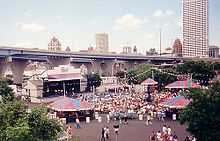 Music stage at Summerfest in 1994, currently called the Harley-Davidson Roadhouse, with Downtown Milwaukee and an approach to the Hoan Bridge in the background.
Music stage at Summerfest in 1994, currently called the Harley-Davidson Roadhouse, with Downtown Milwaukee and an approach to the Hoan Bridge in the background.
The Milwaukee Art Museum in Milwaukee, with its brise soleil designed by Santiago Calatrava, is known for its interesting architecture. The Milwaukee County Zoological Gardens cover over 200 acres (0.81 km2) of land on the far west side of the city. Madison is home to the Vilas Zoo which is free for all visitors, and the Olbrich Gardens conservatory, as well as the hub of cultural activity at the University of Wisconsin–Madison. It is also known for Monona Terrace, a convention center that was designed by Taliesin Architect Anthony Puttnam, based loosely on a 1930s design by Frank Lloyd Wright, a world-renowned architect and Wisconsin native who was born in Richland Center.[74] Wright's home and studio in the 20th century was at Taliesin, south of Spring Green. Decades after Wright's death, Taliesin remains an architectural office and school for his followers.
Music
Wisconsin has more country music festivals than any other state,[75] including Miller Lite Presents Country Fest, Bud Light Presents Country Jam USA, the Coors Hodag Country Festival, Porterfield Country Music Festival, Country Thunder USA in Twin Lakes,[75] and Ford Presents Country USA.
The state's largest city, Milwaukee, also hosts Summerfest, dubbed "The World's Largest Music Festival," every year. This festival is held at the lakefront Henry Maier Festival Park just south of downtown, as are a summer-long array of ethnic musical festivals such as the Milwaukee Irish Fest.
The Wisconsin Area Music Industry provides an annual WAMI event where it presents an awards show for top Wisconsin artists.
Alcohol and Wisconsin culture
Drinking has long been considered a significant part of Wisconsin culture, and the state ranks at or near the top of national measures of per-capita alcohol consumption, binge drinking, driving under the influence, and proportion of drinkers.[76] Factors such as cultural identification with the state's heritage of German immigration, the longstanding presence of major breweries in Milwaukee, and a cold climate are often associated with the prevalence of drinking in Wisconsin.
The Wisconsin Tavern League is a strong political force and the state legislature has been reluctant to lower a DUI offense from BAC 0.10 to 0.08 (only through Federal government influence) and raise the alcoholic beverage tax. The Milwaukee Journal Sentinel series "Wasted in Wisconsin" examined this situation.[77]
Recreation
The varied landscape of Wisconsin makes the state a popular vacation destination for outdoor recreation. Winter events include skiing, ice fishing and snowmobile derbies. Wisconsin has many lakes of varied size; the state contains 11,188 square miles (28,980 km2) of water, more than all but three other states (Alaska, Michigan and Florida).
Outdoor activities are popular in Wisconsin, especially hunting and fishing. One of the most prevalent game animals is the whitetail deer. Each year in Wisconsin, well over 600,000 deer hunting licenses are sold.[78] In 2008, the Wisconsin Department of Natural Resources projected the pre-hunt deer population to be about 1.5 to 1.7 million.
Sports
Wisconsin is represented by major league teams in three sports: football, baseball, and basketball. Lambeau Field, located in Green Bay, Wisconsin, is home to the National Football League's Green Bay Packers. The Packers have been part of the NFL since the league's second season in 1921 and hold the record for the most NFL titles, earning the city of Green Bay the nickname "Titletown USA". The Packers are the smallest city franchise in the NFL, and is the only one owned by shareholders statewide. The franchise was founded by "Curly" Lambeau who played and coached for them. The Green Bay Packers are one of the most successful small-market professional sports franchises in the world and have won 13 NFL championships, including the first two AFL-NFL Championship games (Super Bowls I and II), Super Bowl XXXI and Super Bowl XLV . The state's support of the team is evidenced by the 81,000-person waiting list for season tickets to Lambeau Field.[79]
The Milwaukee Brewers, the state's only major league baseball team, play in Miller Park in Milwaukee, the successor to Milwaukee County Stadium since 2001. In 1982, the Brewers won the American League Championship, marking their most successful season. The team switched from the American League to the National League starting with the 1998 season.
The Milwaukee Bucks of the National Basketball Association play home games at the Bradley Center. The Bucks won the NBA Championship in 1971.
The state also has minor league teams in hockey (Milwaukee Admirals) and baseball (the Wisconsin Timber Rattlers, based in Appleton and the Beloit Snappers of the Class A minor leagues). Wisconsin is also home to the Madison Mallards, the La Crosse Loggers, the Eau Claire Express, the Green Bay Bullfrogs, the Wisconsin Woodchucks, and the Wisconsin Rapids Rafters of the Northwoods League, a collegiate all-star summer league. In arena football Wisconsin is represented by three teams: the Wisconsin Wolfpack in Madison in the CIFL; the Green Bay Blizzard of the IFL, and the Milwaukee Mustangs of the AFL.
Wisconsin also has many college sports programs, including the Wisconsin Badgers, of the University of Wisconsin–Madison and the Panthers of University of Wisconsin – Milwaukee. The Wisconsin Badgers football former head coach Barry Alvarez led the Badgers to three Rose Bowl championships, including back-to-back victories in 1999 and 2000. The Badger men's basketball team won the national title in 1941 and made a second trip to college basketball's Final Four in 2000. The Badgers claimed a historic dual championship in 2006 when both the women's and men's hockey teams won national titles.
The Marquette Golden Eagles of the Big East Conference, the state's other major collegiate program, is known for its men's basketball team, which, under the direction of Al McGuire, won the NCAA National Championship in 1977. The team returned to the Final Four in 2003.
The Semi-Professional Northern Elite Football League consists of many teams from Wisconsin. The league is made up of former professional, collegiate, and high school players. Teams from Wisconsin include: The Green Bay Gladiators from Green Bay, WI, The Fox Valley Force in Appleton, WI, The Kimberly Storm in Kimberly, WI, The Central Wisconsin Spartans in Wausau, WI, The Eau Claire Crush and the Chippewa Valley Predators from Eau Claire, WI, and the Lake Superior Rage from Superior, WI. The league also has teams in Michigan and Minnesota. Teams play from May until August.
Wisconsin is home to the world's oldest operational racetrack. The Milwaukee Mile, located in Wisconsin State Fair Park in West Allis, Wisconsin, held races there long before the Indy 500.[80]
Wisconsin is home to the nation's oldest operating velodrome in Kenosha where races have been held every year since 1927.[81]
See also
- Outline of Wisconsin
- Index of Wisconsin-related articles
- Cheesehead
- Lake Michigan
- Lake Superior
- List of National Register of Historic Places in Wisconsin
- List of people from Wisconsin
- U.S. state
References
- ^ a b "Elevations and Distances in the United States". United States Geological Survey. 2001. http://egsc.usgs.gov/isb/pubs/booklets/elvadist/elvadist.html. Retrieved October 24, 2011.
- ^ a b Elevation adjusted to North American Vertical Datum of 1988.
- ^ 2010 Census Data – 2010 Census
- ^ "Wisconsin's Name: Where it Came from and What it Means". Wisconsin Historical Society. http://www.wisconsinhistory.org/topics/wisconsin-name/. Retrieved 2008-07-24.
- ^ Marquette, Jacques (1673). "The Mississippi Voyage of Jolliet and Marquette, 1673". In Kellogg, Louise P.. Early Narratives of the Northwest, 1634–1699. New York: Charles Scribner's Sons. p. 235. OCLC 31431651. http://www.americanjourneys.org/aj-051/.
- ^ Smith, Alice E. (September 1942). "Stephen H. Long and the Naming of Wisconsin". Wisconsin Magazine of History (Madison, Wisconsin: Wisconsin Historical Society) 26 (1): 67–71. http://content.wisconsinhistory.org/u?/wmh,14413. Retrieved 2008-07-24.
- ^ McCafferty, Michael. 2003. On Wisconsin: The Derivation and Referent of an Old Puzzle in American Placenames. Onoma 38: 39–56
- ^ Vogel, Virgil J. (1965). "Wisconsin's Name: A Linguistic Puzzle". Wisconsin Magazine of History (Madison, Wisconsin: Wisconsin Historical Society) 48 (3): 181–186. http://content.wisconsinhistory.org/u?/wmh,23263. Retrieved 2008-07-24.
- ^ Theler, James; Boszhardt, Robert (2003). Twelve Millennia: Archaeology of the Upper Mississippi River Valley. Iowa City, Iowa: University of Iowa Press. p. 59. ISBN 9780877458470.
- ^ Birmingham, Robert; Eisenberg, Leslie (2000). Indian Mounds of Wisconsin. Madison, Wisconsin: University of Wisconsin Press. pp. 100–110. ISBN 9780299168704.
- ^ Birmingham; Eisenberg (2000). pp. 152–156. ISBN 9780299168704.
- ^ Birmingham; Eisenberg (2000). pp. 165–167. ISBN 9780299168704.
- ^ Boatman, John (1987). "Historical Overview of the Wisconsin Area: From Early Years to the French, British, and Americans". In Fixico, Donald. An Anthology of Western Great Lakes Indian History. University of Wisconsin–Milwaukee. OCLC 18188646.
- ^ Rodesch, Gerrold C. (1984). "Jean Nicolet". University of Wisconsin–Green Bay. http://www.uwgb.edu/wisfrench/library/articles/nicolet.htm. Retrieved 2010-03-13.
- ^ "Turning Points in Wisconsin History: Arrival of the First Europeans". Wisconsin Historical Society. http://www.wisconsinhistory.org/turningpoints/tp-006/?action=more_essay. Retrieved 2010-03-13.
- ^ Jaenen, Cornelius (1973). "French colonial attitudes and the exploration of Jolliet and Marquette". Wisconsin Magazine of History 56 (4): 300–310.
- ^ "Dictionary of Wisconsin History: Langlade, Charles Michel". Wisconsin Historical Society. http://www.wisconsinhistory.org/dictionary/index.asp?action=view&term_id=2266&search_term=Langlade%2C+Charles+Michel. Retrieved 2010-03-13.
- ^ Nesbit, Robert (1973). Wisconsin: A History. Madison: University of Wisconsin Press. pp. 62–64. ISBN 9780299063702.
- ^ "Badger Nickname". University of Wisconsin. http://www.uwbadgers.com/trads/nickname.html. Retrieved 2010-03-14.
- ^ Nesbit (1973). pp. 95–97. ISBN 9780299063702.
- ^ Legler, Henry (1898). "Rescue of Joshua Glover, a Runaway Slave". Leading Events of Wisconsin History. Milwaukee: Sentinel. pp. 226–229. http://www.library.wisc.edu/etext/wireader/WER1124.html. Retrieved 2010-03-13.
- ^ Nesbit (1973). pp. 238–239. ISBN 9780299063702.
- ^ "Turning Points in Wisconsin History: The Iron Brigade, Old Abe and Military Affairs". Wisconsin Historical Society. http://www.wisconsinhistory.org/turningpoints/tp-023/?action=more_essay. Retrieved 2010-03-13.
- ^ Nesbit (1973). p. 273. ISBN 9780299063702.
- ^ Nesbit (1973). pp. 281, 309. ISBN 9780299063702.
- ^ Buenker, John (1998). Thompson, William Fletcher. ed. The Progressive Era, 1893–1914. History of Wisconsin. 4. Madison: State Historical Society of Wisconsin. pp. 25, 40–41, 62. ISBN 9780870203039.
- ^ "Turning Points in Wisconsin History: The Modern Environmental Movement". Wisconsin Historical Society. http://www.wisconsinhistory.org/turningpoints/tp-048/?action=more_essay. Retrieved 2010-03-13.
- ^ Buenker (1998). pp. 80–81. ISBN 9780870203039.
- ^ Ware, Alan (2002). The American direct primary: party institutionalization and transformation in the North. Cambridge, England: Cambridge University Press. p. 118. ISBN 9780521814928.
- ^ Ranney, Joseph. "Wisconsin's Legal History: Law and the Progressive Era, Part 3: Reforming the Workplace". http://www.wisbar.org/AM/TemplateRedirect.cfm?template=/CM/ContentDisplay.cfm&ContentID=35854. Retrieved 2010-03-13.
- ^ Stark, John (1987). "The Establishment of Wisconsin's Income Tax". Wisconsin Magazine of History 71 (1): 27–45.
- ^ Stark, Jack (1995). "The Wisconsin Idea: The University's Service to the State". The State of Wisconsin Blue Book, 1995–1996. Madison: Legislative Reference Bureau. pp. 101–179. OCLC 33902087.
- ^ Nelson, Daniel (1968). "The Origins of Unemployment Insurance in Wisconsin". Wisconsin Magazine of History 51 (2): 109–121.
- ^ "Tommy Thompson: Human Services Reformer". 2004-09-04. http://abcnews.go.com/Politics/story?id=122179&page=1. Retrieved 2010-03-13.
- ^ Lawrence Martin (1965). The physical geography of Wisconsin. University of Wisconsin Press. ISBN 9780299034757. http://books.google.com/?id=QB7qpOSeh6sC&pg=PA247&lpg=PA247&dq=Black+River+Escarpment&q=Black%20River%20Escarpment. Retrieved 2010-09-14.
- ^ "The Eastern Ridges and Lowlands of Wisconsin". Wisconsin Online. http://www.wisconline.com/wisconsin/geoprovinces/easternridges.html. Retrieved 2010-09-14. mirror
- ^ "Wisconsin". National Park Service. http://www.nps.gov/state/wi. Retrieved 2008-07-17.
- ^ "Sister-States and Cities". International Wisconsin. 2006-03-20. http://international.wi.gov/SisterStates.html. Retrieved 2007-03-16.
- ^ Benedetti, Michael. "Climate of Wisconsin". The University of Wisconsin–Extension. http://www.uwex.edu/sco/stateclimate.html. Retrieved 2007-03-16.
- ^ a b c ""Wisconsin: 2010" U.S. Census Bureau" (PDF). http://quickfacts.census.gov/qfd/states/55000.html. Retrieved 2011-07-25.
- ^ "Wisconsin Blue Book 2003–2004" (PDF). http://www.legis.state.wi.us/LRB/bb/03bb/128-133.pdf. Retrieved 2010-07-25.
- ^ Miller, Frank Hayden, "The Polanders in Wisconsin." Parkman Club Publications No. 10. Milwaukee, Wis.: Parkman Club, 1896); Online facsimile at: The Wisconsin Historical Society, visited January 29, 2008
- ^ "Wisconsin's Hmong Population" (PDF). University of Wisconsin–Madison Applied Population Laboratory. http://www.apl.wisc.edu/publications/HmongChartbook.pdf. Retrieved 2010-04-26.
- ^ "State Membership Reports". thearda.com. http://www.thearda.com/mapsReports/reports/state/55_2000.asp. Retrieved 2010-06-15.
- ^ Carroll, Brett E. (2000-12-28). The Routledge Historical Atlas of Religion in America. Routledge Atlases of American History. Routledge. ISBN 0415921376.
- ^ Table 5 – Crime in the United States 2009
- ^ Office of Justice Assistance
- ^ http://oja.wi.gov/docview.asp?docid=19873&locid=97
- ^ Office of Justice Assistance – Sexual Assaults
- ^ Conant, James K. (2006-03-01). "1". Wisconsin Politics and Government: America's Laboratory of Democracy. University of Nebraska Press. ISBN 0803215487.
- ^ "Wisconsin Assembly passes bill to curb collective bargaining". CNN. March 10, 2011. http://www.cnn.com/2011/POLITICS/03/10/wisconsin.budget/index.html?hpt=T1&iref=BN1.
- ^ http://www.govtrack.us/congress/person.xpd?id=400300
- ^ Smith, Kevin D. (Spring 2003). "From Socialism to Racism: The Politics of Class and Identity in Postwar Milwaukee". Michigan Historical Review 29 (1): 71–95. doi:10.2307/20174004.
- ^ Bull, Chris (1999-02-16). "Take a seat – openly lesbian Representative Tammy Baldwin". The Advocate (LPI Media). Archived from the original on 2005-06-25. http://web.archive.org/web/20050625081817/http://www.findarticles.com/p/articles/mi_m1589/is_1999_Feb_16/ai_53877986. Retrieved 2007-03-16.
- ^ "County Sales Tax Distribution-2007". Wisconsin Department of Revenue. 2007-03-06. http://www.revenue.wi.gov/esd/cotax07.html. Retrieved 2007-03-24.
- ^ "Wisconsin Department of Revenue". Revenue.wi.gov. http://www.revenue.wi.gov/faqs/ise/estate.html#ret3. Retrieved 2010-07-25.
- ^ "GDP by State". Greyhill Advisors. http://greyhill.com/gdp-by-state. Retrieved 7 September 2011.
- ^ [1]; WI June 2010 unemployment rates
- ^ Wisconsin's Large Employer Search
- ^ "Total Cheese Production Excluding Cottage Cheese – States and United States: February 2010 and 2011" in United States Department of Agriculture, Dairy Products, p. 13.
- ^ "American Cheese Production – States and United States: February 2010 and 2011" in United States Department of Agriculture, Dairy Products, p. 14.
- ^ "Milk Cows and Production – 23 Selected States: February 2010 and 2011" in United States Department of Agriculture, Milk Production, p. 3.
- ^ "Table 6: Per Capita Milk Production by State, 2003" in CITEC, The Dairy Industry in the U.S. and Northern New York, p. 25.
- ^ Wisconsin Milk Marketing Board, Wisconsin's Rank in the Nations's Dairy Industry: 2007
- ^ a b U.S. Department of Agriculture, Wisconsin – Cranberries, p. 1.
- ^ a b United States Department of Agriculture, "American Ginseng – Rooted in Wisconsin", Census of Agriculture, September, 1995.
- ^ Walters, Steven. "Doyle flips decision, puts cow on quarter". Milwaukee Journal Sentinel. Archived from the original on 2007-03-21. http://web.archive.org/web/20070321031237/http://www.jsonline.com/story/index.aspx?id=173693. Retrieved 2007-03-30.
- ^ ""Commerce study slams film incentives law" ''The Business Journal of Milwaukee'' March 31, 2009". Bizjournals.com. 2009-03-31. http://www.bizjournals.com/milwaukee/stories/2009/03/30/daily29.html. Retrieved 2010-07-25.
- ^ Naylor. "Number and Percent of Total Population by Urban/Rural Categories for Wisconsin Counties: April 1, 2000" (PDF). State of Wisconsin, Department of Administration. http://www.doa.state.wi.us/docs_view2.asp?docid=418. Retrieved 2007-03-16.
- ^ Davis, Chase; Rick Romell. "City drops out of top 20". Milwaukee Journal Sentinel (Journal Communications). Archived from the original on 2007-03-10. http://web.archive.org/web/20070310214138/http://www.jsonline.com/story/index.aspx?id=337561. Retrieved 2007-03-16.
- ^ U.S. Census Bureau, "Wisconsin – Place and County Subdivision. GCT-T1-R. Population Estimates"[2]
- ^ Rudolph, Frederick (1990). The American College and University: A History.. The University of Georgia Press, Athens and London.
- ^ Christopulos, Mike and Joslyn, Jay. "Legislators took license with ideas for slogan on plate" Milwaukee Sentinel 12-27-85; Page 5, Part 1
- ^ Pure Contemporary interview with Anthony Puttnam
- ^ a b Winterroth, Scott (2011). "Wisconsin Country Music Festivals". Country Music Chicago. http://countrymusicchicago.com/category/wisc-country-fests/. Retrieved 7 April 2011.
- ^ ""Drinking deeply ingrained in Wisconsin's culture" home page". Jsonline.com. http://www.jsonline.com/news/wisconsin/31237904.html. Retrieved 2011-08-18.
- ^ ""Wasted in Wisconsin" home page". Jsonline.com. http://www.jsonline.com/news/30565984.html. Retrieved 2010-07-25.
- ^ "A Chronology Of Wisconsin Deer Hunting From Closed Seasons To Antlerless Permits" (Press release). Wisconsin Department of Natural Resources. 2005-11-12. Archived from the original on 2007-02-11. http://web.archive.org/web/20070211061345/http://www.dnr.state.wi.us/org/caer/ce/news/rbnews/2005/111205scr4.htm. Retrieved 2007-03-16.
- ^ Green Bay Packers, Inc., Fan Zone FAQ, accessed Feb. 28, 2010.
- ^ "Milwaukee Mile Website – History". Milwaukeemile.com. http://www.milwaukeemile.com/History-2010.asp. Retrieved 2010-07-25.
- ^ "Kenosha Velodrome Association". 333m.com. http://www.333m.com/. Retrieved 2010-07-25.
Further reading
- Barone, Michael; Cohen, Richard E. (2005). The Almanac of American Politics, 2006. Washington, DC: National Journal. ISBN 0892341122.
- Current, Richard (2001). Wisconsin: A History. Urbana: University of Illinois Press. ISBN 0252070186.
- Gara, Larry (1962). A Short History of Wisconsin. Madison: State Historical Society of Wisconsin.
- Holmes, Fred L. (1946). Wisconsin. 5 vols. Chicago. Detailed popular history and many biographies.
- Nesbit, Robert C. (1989). Wisconsin: A History (Rev. ed.). Madison: University of Wisconsin Press. ISBN 0299108007.
- Pearce, Neil (1980). The Great Lakes States of America. New York: Norton. ISBN 0393056198.
- Quaife, Milo M. (1924). Wisconsin, Its History and Its People, 1634–1924. 4 vols. Detailed popular history & biographies.
- Raney, William Francis (1940). Wisconsin: A Story of Progress. New York: Prentice-Hall.
- Robinson, Arthur H.; Culver, J. B., eds (1974). The Atlas of Wisconsin.
- Sisson, Richard, ed (2006). The American Midwest: An Interpretive Encyclopedia. Bloomington: Indiana University Press. ISBN 0253348862.
- Van Ells, Mark D. (2009). Wisconsin [On-The-Road Histories]. Northampton MA: Interlink Books. ISBN 978-1-56656-673-5.
- Vogeler, I. (1986). Wisconsin: A Geography. Boulder: Westview Press. ISBN 0865314926.
- Wisconsin Cartographers' Guild (2002). Wisconsin's Past and Present: A Historical Atlas.
- Works Progress Administration (1941). Wisconsin: A Guide to the Badger State. Detailed guide to every town and city, and cultural history.
- See additional books at History of Wisconsin
External links
- Map of Wisconsin at nationalatlas.gov
- State of Wisconsin
- Wisconsin state symbols
- Wisconsin State Legislature
- Wisconsin Court System
- Wisconsin State Facts
- Wisconsin Health and Demographic Data
- Energy Profile for Wisconsin – Economic, environmental, and energy data
- Wisconsin Historical Society
- The State of Wisconsin Collection from the UW Digital Collections Center
- Wisconsin Free Speech Legacy
- Wisconsin Department of Tourism
- Travel Information- Traveling by publuic transit(Wisconsin Department of Transportation)
- Wisconsin travel guide from Wikitravel
- Wisconsin at the Open Directory Project

 Canada
Canada
Lake Superior • UP of Michigan
 Minnesota
Minnesota
Lake Michigan  Wisconsin: Outline • Index
Wisconsin: Outline • Index 

 Iowa
Iowa Illinois
Illinois Indiana
IndianaPolitical divisions of the United States States - Alabama
- Alaska
- Arizona
- Arkansas
- California
- Colorado
- Connecticut
- Delaware
- Florida
- Georgia
- Hawaii
- Idaho
- Illinois
- Indiana
- Iowa
- Kansas
- Kentucky
- Louisiana
- Maine
- Maryland
- Massachusetts
- Michigan
- Minnesota
- Mississippi
- Missouri
- Montana
- Nebraska
- Nevada
- New Hampshire
- New Jersey
- New Mexico
- New York
- North Carolina
- North Dakota
- Ohio
- Oklahoma
- Oregon
- Pennsylvania
- Rhode Island
- South Carolina
- South Dakota
- Tennessee
- Texas
- Utah
- Vermont
- Virginia
- Washington
- West Virginia
- Wisconsin
- Wyoming
Federal district Insular areas Outlying islands Preceded by
IowaList of U.S. states by date of statehood
Admitted on May 29, 1848 (30th)Succeeded by
CaliforniaCoordinates: 44°30′N 89°30′W / 44.5°N 89.5°W
United States (Outline) History Pre-Columbian era · Colonial era (Thirteen Colonies · Colonial American military history) · American Revolution (War) · Federalist Era · War of 1812 · Territorial acquisitions · Territorial evolution · Mexican–American War · Civil War · Reconstruction era · Indian Wars · Gilded Age · African-American Civil Rights Movement (1896–1954) · Spanish–American War · Imperialism · World War I · Roaring Twenties · Great Depression · World War II (Home front) · Cold War · Korean War · Space Race · African-American Civil Rights Movement (1955–1968) · Feminist Movement · Vietnam War · Post-Cold War (1991–present) · War on Terror (War in Afghanistan · Iraq War) · Timeline of modern American conservatismTopicsDemographic · Discoveries · Economic (Debt Ceiling) · Inventions (before 1890 · 1890–1945 · 1946–1991 · after 1991) · Military · Postal · Technological and industrialFederal
governmentLegislature - Congress
Senate
· Vice President
· President pro tem
House of Representatives
· Speaker
Judiciary - Supreme Court
Federal courts
Courts of appeal
District courtsExecutive - President
Executive Office
Cabinet / Executive departments
Civil service
Independent agencies
Law enforcement
Public policy
Intelligence
Central Intelligence Agency
Defense Intelligence Agency
National Security Agency
Federal Bureau of InvestigationPolitics Divisions · Elections (Electoral College) · Foreign policy · Foreign relations · Ideologies · Local governments · Parties (Democratic Party · Republican Party · Third parties) · Political status of Puerto Rico · Red states and blue states · Scandals · State governments · Uncle SamGeography Cities, towns, and villages · Counties · Extreme points · Islands · Mountains (Peaks · Appalachian · Rocky) · National Park System · Regions (Great Plains · Mid-Atlantic · Midwestern · New England · Northwestern · Southern · Southwestern · Pacific · Western) · Rivers (Colorado · Columbia · Mississippi · Missouri · Ohio · Rio Grande) · States · Territory · Water supply and sanitationEconomy Agriculture · Banking · Communications · Companies · Dollar · Energy · Federal Budget · Federal Reserve System · Financial position · Insurance · Mining · Public debt · Taxation · Tourism · Trade · Transportation · Wall StreetSociety TopicsCrime · Demographics · Education · Family structure · Health care · Health insurance · Incarceration · Languages (American English · Spanish · French) · Media · People · Public holidays · Religion · SportsArchitecture · Art · Cinema · Cuisine · Dance · Fashion · Flag · Folklore · Literature · Music · Philosophy · Radio · Television · TheaterIssuesCategories:- Wisconsin
- States of the United States
- States and territories established in 1848
Wikimedia Foundation. 2010.


